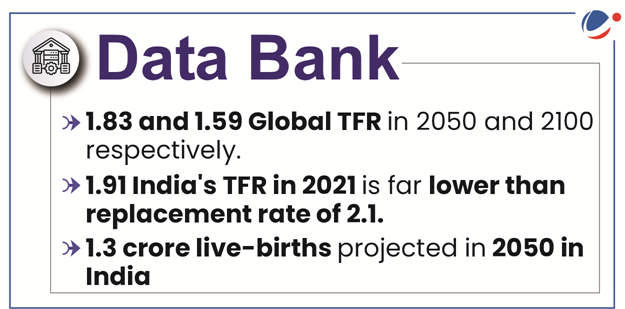Why in the news?
Recently, the Global Burden of Disease Study 2021 published in Lancet highlighted that India’s Total Fertility Rate (TFR) is projected to fall to 1.29 and 1.04 in 2050 and 2100 respectively.
What is the Total Fertility Rate?
- Total Fertility Rate may be defined as average number of children that would be born to a woman if she experiences the current fertility pattern throughout her reproductive span (15-49 years).
- A TFR of 2.1 i.e., two children per women is considered the replacement rate for a population, resulting in relative stability in terms of total population numbers.

Reasons for declining Total Fertility Rate
- Educational Opportunities: Increased education of women leads to improved contraception use, child health, and workforce participation, consequently lowering fertility rates.
- Family Planning (FP): Government-led FP initiatives enable couples to decide on child number and spacing, resulting in declining TFR.
- Delayed Marriage: The average age of first pregnancy has dropped from the mid-20 to mid to late 30’s, due to delays in the age of marriage.
- Infertility: The TFR rate faces a sharp decline due to rising concern over lifestyle factors like obesity, stress, smoking, and increased pollution leading to infertility among couples.
- The general fertility rate in India has fallen 20 per cent in 10 years, with nearly 30 million people affected by infertility.
- Child mortality: With improvements in child health services, and immunisation programs, child mortality rates have declined, further leading to a decline in TFR.
Impact of declining Total Fertility Rate
Positive impact
- Resource mobilisation: A falling fertility rate will lead to lower pressure on land, water and other resources and would contribute to achieving environmental goals.
- Educational Efficiency: Declining TFR could improve educational outcomes without additional resources being spent per capita by the state, as the number of enrolling children will decrease.
Negative impact
- Increase in dependency ratio: Sustained low fertility will produce a contracting population with fewer young people relative to older people as noted in China, Japan etc., leading to an increase in the dependency ratio.
- Fiscal challenges: A decreased working-age population, along with the increase in spending on social security, pensions, geriatric care etc. would put pressure on the fiscal resources of the country.
- Labour Force: Lower TFR can adversely affect economic productivity and growth due to a shortage of skilled workers, further leading to labour market imbalances and potential economic stagnation.
- Migration: Declining fertility rates can impact migration patterns. Countries with ageing populations may attract immigrants to address workforce shortages, fostering diversity and immigration policy tensions.
- Shifting Family Dynamics: Decreasing family size can disrupt traditional support systems like grandparental childcare, potentially increasing elder loneliness, psychological issues etc. due to the rise in nuclear families.
Way ahead
- Enhancing Support: Governments and businesses should focus on childcare support, provide tax subsidies, improve parental leave entitlements etc. to make child-bearing affordable for the working parents.
- Gender equity: For women to be able to manage careers with motherhood, it would be crucial for men to take greater responsibility for household and care work.
- Economic Policies: To combat potential threats to public health, economic policies stimulating growth and job creation, alongside social security and pension reforms, will be essential in mitigating the impacts of declining fertility rates.
- Skill enhancement: To make sure that an ageing population does not become an economic disaster, the working-age population, regardless of its size, and age, should be equipped with the necessary skills to boost their productivity.



